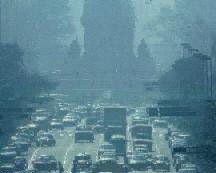 |
 |
 |
 Editorials | Environmental | May 2005 Editorials | Environmental | May 2005  
Capital City Temps Show Notable Rise Over Last Century
 Angélica Simón - El Universal Angélica Simón - El Universal


| Smog surrounds the Angel Monument in Mexico City, Mexico, during a thermal inversion. Air pollution increases dramatically as a mass of cold air is trapped below a warmer mass of air. The absence of wind circulation prevents pollution near the earth’s surface from escaping.
(Photo: Wesley Bocxe) |
Mexico City - The average global temperature has increased an estimated 0.6 C or about 1.1. F over the last 100 years, meanwhile in the same span of time the average temperature of what has become one of the Earth's largest cities has risen a full 4 C, or 7.2 F, according to Victor Magaña Rueda, a researcher at the Center for Atmospheric Sciences at UNAM.

At a forum earlier this month on air quality and climate change organized by the Environment Secretariat (Semarnat), Magaña Rueda discussed how the capital city is heating up around six times faster than the globe at large explaining how the process of urbanization is to blame for the increase.

Examining the results, the scientist showed that the average temperature now is 18 C or 64 F, where a century ago it was 14 C or 57 F.

"As concrete continues to replace trees in the urbanization process, we are causing this very local, very notable rise in heat," he said.

This rise will alter the rain cycles. The more heat, the more water vapor, the more rain and floods, he said.

"It will rain more and longer and more days raising the risk of city flooding," said Magaña Rueda.

On the other hand, droughts will be more frequent and longer raising the risk of fires and water shortages.

The city has become what scientists call an Urban Heat Island, due to a complex blend of the higher heat capacity of brick, concrete and asphalt, less vegetative cover and lowered wind speeds due to blocking structures.

According to Magaña Rueda, this overall increased heat will result in more extreme temps and weather phenomenon including: record-breaking high and low temperatures, more frequent and more powerful storms, with more flooding as well as longer dry spells. The experimental results show there are already indications that these phenomenon have begun.

Recently, the capital has registered temperatures hitting historic highs, including an all time high of 35 C, or 95 F, in 1998.

In April and the first days of May, the city was plunged into a sweltering heat wave where temps in some parts of the city went above the 30 C (86 F) mark on more than one occasion as the highs for all but two days were between 2 C and 6 C above the historical average.

The problem, he said, was that the city and its residents are not prepared to confront these type of events at the frequency they are thought to be coming.

Known for its mild climate, Mexico City residents have had little need for either air conditioning or heating, luxuries that relatively few can actually afford. In addition, the rainy season spells calamity for countless residents with flooding especially to the thousands of residents living in low-income often makeshift housing in flood-prone areas. With more frequent flooding, the situation only looks more dismal.

Magaña Rueda went on to predict that over the next 20 years the temperature could increase a further 2 C, or 3.6 F, as the city grows.

Magaña Rueda warned that as the temperatures increase the populace will become more vulnerable and should be aware of impending problems. | 
 | |
 |



